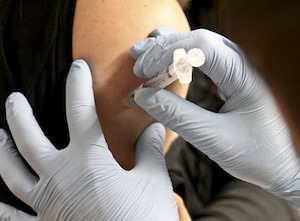Why We Still Fear Vaccines
Writing in Harper’s Magazine, author and mother Eula Biss places the common American fear of vaccination within a history of religion and midwifery, the anxieties of social class, “debates over the integrity of science” and the decision whether to vaccinate her own son.
Writing in Harper’s Magazine, author and mother Eula Biss places the common American fear of vaccination within a history of religion and midwifery, the anxieties of social class, “debates over the integrity of science” and the decision whether to vaccinate her own son.
“Vaccination,” Biss writes, “is sometimes implicated in all the crimes of modern medicine. But vaccination was a precursor to modern medicine, not the product of it. Its roots are in folk medicine, and its first practitioners were farmers. Milkmaids in eighteenth-century England had faces unblemished by smallpox, as anyone could see. Common wisdom held that if a milkmaid milked a cow blistered with cowpox and developed some blisters on her hands, she would not contract smallpox even while nursing victims of an epidemic.”
Curiosity about cases like the milkmaid’s apparent immunity led a farmer in 1774 to inject his wife and children with pus squeezed from a cow’s udder. Although the mother grew ill and met a fate not mentioned by the article, the sons lived never to contract the disease. Twenty years later, a country doctor named Edward Jenner performed similar experiments to similar effect, and eventually the French Enlightenment writer Voltaire urged his countrymen to adopt the practice of variolation by, among other methods, introducing the infectious material into a small slit in the skin.
The innovations were “based entirely on observation, not on theory,” Biss writes, driving home the fact that roots of the practice lie in folk medicine, rather than science.
With brief references to chemicals that are either naturally present in the body or there because one lives in an industrial society, with all of its pesticides and manufactured chemicals, Biss does away with unscientific fears that vaccinations have become another way to introduce dangerous toxins and pollutants into the body. The apprehension remains common however, especially among mothers.
When the H1N1 pandemic was at its height and her son was 6 months old, debates she held with other mothers centered on the belief that “our bodies are inherently disconnected from other bodies.” The idea led some mothers to disbelieve in the notion of “herd immunity,” an observable phenomenon by which a population shares the biological material necessary to ward off dangerous infections. Unfortunately, the term invites association with the term “herd mentality, a stampede toward stupidity,” that contradicts the “frontier mentality” by which many Americans imagine their bodies as “isolated homesteads.” “The health of the homestead next to ours does not affect us, this thinking suggests, so long as ours is well tended.”
A better idea, Biss suggests, is to recast the herd as a hive, similar to honeybees, in which the health of individuals is absolutely dependent upon the health of their community.
Correspondingly, “if we imagine the action of a vaccine not just in terms of how it affects a single body but also in terms of how it affects the collective body of a community, it is fair to think of vaccination as a kind of banking of immunity,” she writes. “Contributions to this bank are donations to those who cannot or will not be protected by their own immunity.” It’s by this principle that “mass vaccination becomes far more effective than individual vaccination.”
The value of independence and the strength that is typically thought to accompany it stands as one of the biggest obstacles between a community and its organized protection against disease. The virtues of isolation play out in the sense of the food and other substances people put into their bodies and what segments of the population they come into contact with. Biss recognizes that theme bears a relation to the notion of purity, a prized and ill-defined condition that has played a role in American social history.
[Unfortunately, Biss’ article is available only by subscription to Harper’s Magazine. For those who aren’t subscribers, the link below will lead to a brief sample of the essay’s entire text.]
— Posted by Alexander Reed Kelly.
Your support matters…Eula Biss in Harper’s Magazine:
Purity is the seemingly innocent concept behind a number of the most sinister social actions of the past century. A passion for bodily purity drove the eugenics movement and led to the sterilization of women and men who were deaf, blind, disabled, or just poor. Concerns for bodily purity were behind miscegenation laws that persisted more than a century after the abolition of slavery, and behind the sodomy laws that were only recently declared unconstitutional. Quite a bit of human solidarity, it seems, has been sacrificed to preserve some kind of imagined purity.
If we do not yet know exactly what the presence of a vast range of chemicals in umbilical-cord blood and breast milk might mean for the future of our children’s health, we do at least know that we are no cleaner, even at birth, than our environment at large. We have more microorganisms in our guts than we have cells in our bodies — we are crawling with bacteria and we are full of chemicals. We are, in other words, continuous with everything here on earth. Including — and especially — each other.
Independent journalism is under threat and overshadowed by heavily funded mainstream media.
You can help level the playing field. Become a member.
Your tax-deductible contribution keeps us digging beneath the headlines to give you thought-provoking, investigative reporting and analysis that unearths what's really happening- without compromise.
Give today to support our courageous, independent journalists.





You need to be a supporter to comment.
There are currently no responses to this article.
Be the first to respond.